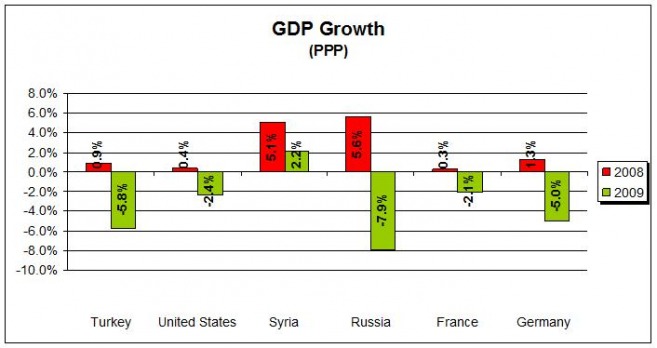Economic Status of Turkey
To measure the economic growth of a country, which is the increase or decrease in Real GDP, the percent change of Real GDP must be measured with the calculation of ((Real GDPnew – Real GDPold)/Real GDPold)*100.
Turkey’s 2009 GDP Growth Rate of -5.8% is calculated by using the formula listed above
(($861.8b - $914.7b)/$914.7b)*100 = -5.8%. This means that Turkey has experience a decline in their economic growth of 5.8% so their economy is shrinking. If the percentage change were greater than zero, the economy would be growing.
In 2009, the United States’ economy shrunk by 2.4%. Russia, France and Germany all experienced a shrinking economy of 7.9%, 2.1% and 5.0% respectively. Syria, a neighboring country of Turkey, however, experienced economic growth of 2.2% in 2009.
The rate of economic growth is not consistent with what Turkey has experienced in the past because in 2008 their GDP Growth Rate was 0.9%, which was still greater than zero, meaning that the economy grew. Turkey’s largest industry, which employs 24.7% of the 24.2 million people employed, “is textiles and clothing, which accounts for one-third of industrial employment” (www.cia.gov). The textiles and apparel also make up a portion of the $111.1 billion in exports around the world. This high reliance on exports may be harmful to Turkey’s economy “in 2010 as the global economic slowdown continues to curb demand for Turkish exports” (www.cia.gov). This economic slowdown is evident when comparing Turkey’s economy with the United States, Russia, France and Germany.
Turkey’s 2009 GDP Growth Rate of -5.8% is calculated by using the formula listed above
(($861.8b - $914.7b)/$914.7b)*100 = -5.8%. This means that Turkey has experience a decline in their economic growth of 5.8% so their economy is shrinking. If the percentage change were greater than zero, the economy would be growing.
In 2009, the United States’ economy shrunk by 2.4%. Russia, France and Germany all experienced a shrinking economy of 7.9%, 2.1% and 5.0% respectively. Syria, a neighboring country of Turkey, however, experienced economic growth of 2.2% in 2009.
The rate of economic growth is not consistent with what Turkey has experienced in the past because in 2008 their GDP Growth Rate was 0.9%, which was still greater than zero, meaning that the economy grew. Turkey’s largest industry, which employs 24.7% of the 24.2 million people employed, “is textiles and clothing, which accounts for one-third of industrial employment” (www.cia.gov). The textiles and apparel also make up a portion of the $111.1 billion in exports around the world. This high reliance on exports may be harmful to Turkey’s economy “in 2010 as the global economic slowdown continues to curb demand for Turkish exports” (www.cia.gov). This economic slowdown is evident when comparing Turkey’s economy with the United States, Russia, France and Germany.

